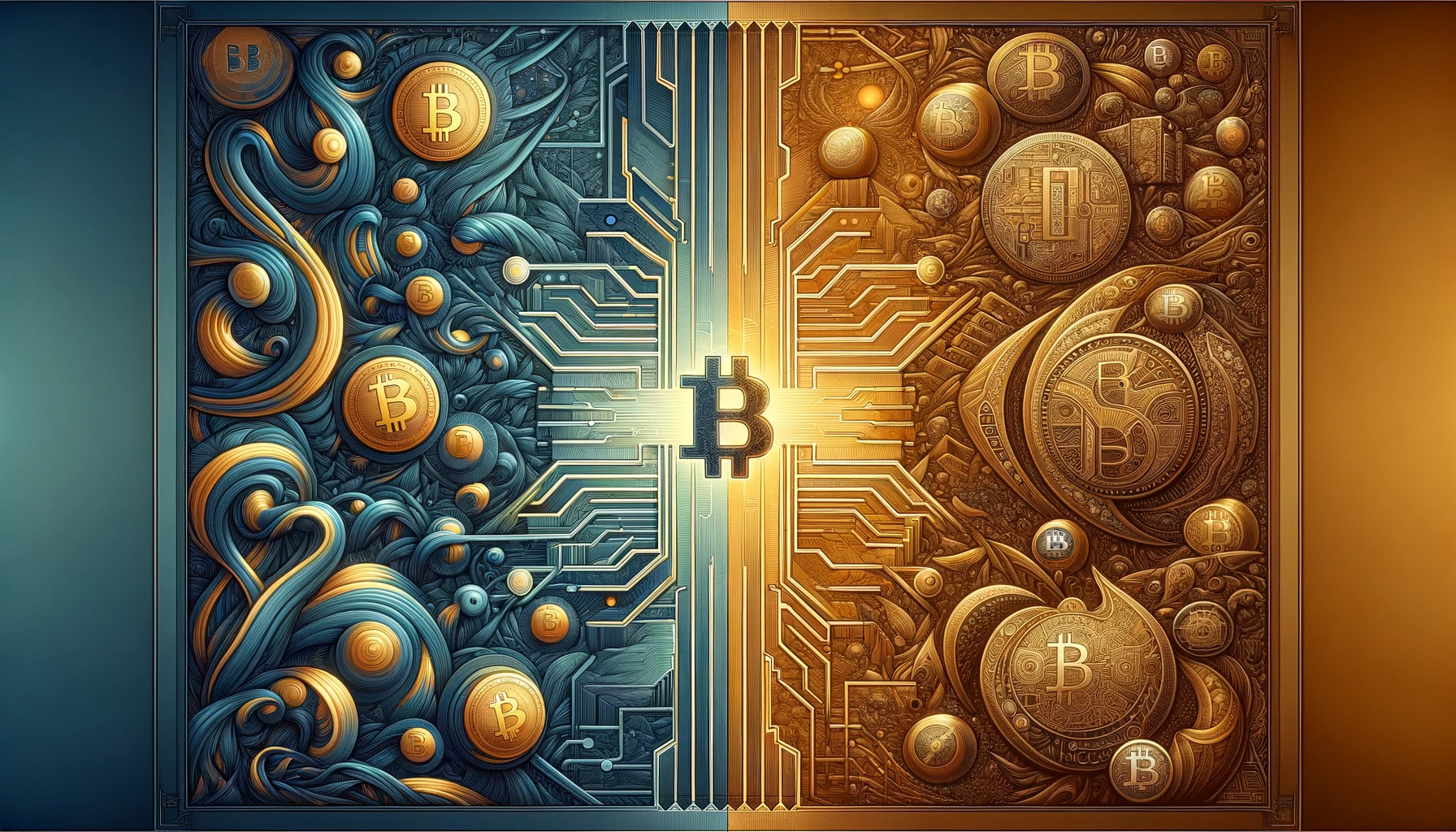6 Jun, 24
Bitcoin Runes and Bitcoin Ordinals: Key Features

Bitcoin, originally designed as a decentralized digital currency, has grown to include a wide range of functionalities thanks to its robust underlying blockchain technology. Two notable advancements in the Bitcoin ecosystem are Bitcoin Runes and Bitcoin Ordinals. These technologies enhance Bitcoin’s utility but serve different purposes and operate in distinct ways. This article explores the key features of Bitcoin Runes and Bitcoin Ordinals, highlighting their differences and potential applications.

Bitcoin Runes and Bitcoin Ordinals are innovative protocols built on the Bitcoin blockchain, designed to extend its capabilities beyond simple transactions. Bitcoin Runes focus on creating fungible tokens with enhanced efficiency and user experience, while Bitcoin Ordinals facilitate the creation of unique digital assets, often likened to NFTs, by inscribing data onto individual satoshis. Understanding these technologies is essential for anyone interested in the evolving landscape of Bitcoin and blockchain applications.
Bitcoin Runes: Adding Programmability to Bitcoin
Bitcoin Runes introduce a new token standard on the Bitcoin network, aimed at creating and managing fungible tokens efficiently. Developed by Casey Rodarmor, the same mind behind Bitcoin Ordinals, Runes leverage Bitcoin’s UTXO (Unspent Transaction Output) model. This approach offers several advantages:
- UTXO Model Integration: Runes integrate seamlessly with Bitcoin’s existing architecture, enhancing security and reducing blockchain bloat by using the OP_RETURN field to store token data. This minimizes the on-chain footprint and optimizes the network’s resource use (Crypto.com) (DoomDroom).
- Token Creation and Management: Runes utilize a process called “etching” to create tokens. Etching involves embedding specific parameters, such as token name, symbol, supply, and divisibility, into the Bitcoin transaction outputs. Once etched, these tokens can be minted either through open or closed minting processes (Kraken) (CryptExchange).
- Improved Efficiency: By focusing on the UTXO model, Runes provide a more efficient alternative to existing token standards like BRC-20. This model reduces the clutter created by unspent transaction outputs, improving the overall scalability and user experience of the Bitcoin network (UD Blockchain) (Kraken).
- Enhanced Security: Leveraging Bitcoin’s robust security framework, Runes transactions are inherently secure. Invalid transactions result in burning the involved runes, ensuring that only valid tokens remain in circulation (Crypto.com) (DoomDroom).
- Broader Use Cases: Runes can be used to create various types of tokens, including stablecoins, loyalty points, and tokenized assets, providing a flexible and versatile tool for developers and businesses (UD Blockchain).
Bitcoin Ordinals: Unique Digital Assets
Bitcoin Ordinals, also developed by Casey Rodarmor, allow for the creation of unique digital assets on the Bitcoin blockchain. This protocol uses the concept of “inscriptions” to attach data to individual satoshis, effectively turning them into unique, identifiable assets similar to NFTs.
- Inscriptions on Satoshis: Ordinals work by inscribing data onto satoshis, the smallest unit of Bitcoin. Each inscribed satoshi becomes a unique digital artifact, traceable and verifiable on the Bitcoin blockchain (Crypto.com) (DoomDroom).
- Custom Scripting and Scalability: Implementing and managing Ordinals inscriptions can be complex due to the limited space available for data in Bitcoin transactions and the need for custom scripting. This complexity can lead to scalability challenges if widely adopted, as large inscriptions might congest the network (UD Blockchain) (CryptExchange).
- Non-Fungible Characteristics: Unlike Runes, which focus on fungible tokens, Ordinals create non-fungible assets. Each inscribed satoshi is unique, making Ordinals suitable for applications that require distinct digital identities, such as collectibles, digital art, and proof of ownership (DoomDroom) (Kraken).
- Potential Use Cases: Ordinals can be used for various purposes, including creating digital art, certifying digital ownership, and developing decentralized identity systems. Their ability to create unique and traceable digital assets opens up new possibilities for innovation on the Bitcoin network (DoomDroom) (UD Blockchain).
- Security and Best Practices: Like Runes, Ordinals benefit from Bitcoin’s security features. However, the custom scripting required for inscriptions introduces potential security risks if not implemented correctly. Developers must adhere to best practices to ensure the integrity and security of Ordinals-based applications (UD Blockchain).
Differences Between Bitcoin Runes and Bitcoin Ordinals
While both Bitcoin Runes and Bitcoin Ordinals enhance the Bitcoin ecosystem, they do so in different ways:
- Token Type:
- Runes: Focus on creating fungible tokens, similar to Ethereum’s ERC-20 tokens.
- Ordinals: Enable the creation of unique, non-fungible tokens (NFTs) by inscribing data onto individual satoshis (DoomDroom) (CryptExchange).
- Technical Implementation:
- Runes: Use the UTXO model, leveraging Bitcoin’s existing transaction structure to minimize on-chain data and optimize efficiency.
- Ordinals: Utilize inscriptions on satoshis, which require custom scripting and can lead to scalability issues due to the larger data size (UD Blockchain) (Kraken).
- Scalability and Efficiency:
- Runes: Designed for efficiency and scalability, reducing blockchain bloat and improving transaction speeds.
- Ordinals: May face scalability challenges if widely adopted due to the large size of inscriptions and the need for additional data management (UD Blockchain) (CryptExchange).
- Use Cases:
- Runes: Suitable for creating a wide range of fungible tokens, including stablecoins, loyalty points, and tokenized assets.
- Ordinals: Best suited for applications requiring unique digital assets, such as digital art, collectibles, and proof of ownership systems (Crypto.com) (UD Blockchain).
Conclusion
Bitcoin Runes and Bitcoin Ordinals represent significant advancements in the Bitcoin ecosystem, each catering to different needs and applications. Runes enhance the network’s efficiency and scalability by providing a robust framework for creating fungible tokens, while Ordinals open up new possibilities for unique digital assets. Understanding the key features and differences between these protocols is essential for developers, businesses, and enthusiasts looking to leverage Bitcoin’s full potential.
FAQs
- What are Bitcoin Runes?
- Bitcoin Runes are a protocol for creating fungible tokens on the Bitcoin network using the UTXO model. They offer improved efficiency and security compared to other token standards.
- How do Bitcoin Ordinals work?
- Bitcoin Ordinals inscribe data onto individual satoshis, creating unique digital assets similar to NFTs. Each inscribed satoshi can be traced and verified on the Bitcoin blockchain.
- What are the main differences between Bitcoin Runes and BRC-20 tokens?
- Bitcoin Runes use the UTXO model and are designed for efficiency and scalability, while BRC-20 tokens use an account-based model and can create network congestion due to their larger data size.
- Can Bitcoin Runes and Ordinals be used together?
- Yes, there is potential for interoperability. For example, an Ordinal inscription could serve as a unique identifier for a fungible Rune token, combining the benefits of both protocols.
- What are some potential applications of Bitcoin Ordinals?
- Bitcoin Ordinals can be used for digital art, collectibles, proof of ownership, and decentralized identity systems, among other applications.
About Zerocap
Zerocap provides digital asset liquidity and digital asset custodial services to forward-thinking investors and institutions globally. For frictionless access to digital assets with industry-leading security, contact our team at hello@zerocap.com or visit our website www.zerocap.com
DISCLAIMER
This material is issued by Zerocap Pty Ltd (Zerocap), a Corporate Authorised Representative (CAR: 001289130) of AFSL 340799. Material covering regulated financial products is issued to you on the basis that you qualify as a “Wholesale Investor” for the purposes of Sections 761GA and 708(10) of the Corporations Act 2001 (Cth) (Sophisticated/Wholesale Client). This material is intended solely for the information of the particular person to whom it was provided by Zerocap and should not be relied upon by any other person. The information contained in this material is general in nature and does not constitute advice, take into account the financial objectives or situation of an investor; nor a recommendation to deal. Any recipients of this material acknowledge and agree that they must conduct and have conducted their own due diligence investigation and have not relied upon any representations of Zerocap, its officers, employees, representatives or associates. Zerocap has not independently verified the information contained in this material. Zerocap assumes no responsibility for updating any information, views or opinions contained in this material or for correcting any error or omission which may become apparent after the material has been issued. Zerocap does not give any warranty as to the accuracy, reliability or completeness of advice or information which is contained in this material. Except insofar as liability under any statute cannot be excluded, Zerocap and its officers, employees, representatives or associates do not accept any liability (whether arising in contract, in tort or negligence or otherwise) for any error or omission in this material or for any resulting loss or damage (whether direct, indirect, consequential or otherwise) suffered by the recipient of this material or any other person. This is a private communication and was not intended for public circulation or publication or for the use of any third party. This material must not be distributed or released in the United States. It may only be provided to persons who are outside the United States and are not acting for the account or benefit of, “US Persons” in connection with transactions that would be “offshore transactions” (as such terms are defined in Regulation S under the U.S. Securities Act of 1933, as amended (the “Securities Act”)). This material does not, and is not intended to, constitute an offer or invitation in the United States, or in any other place or jurisdiction in which, or to any person to whom, it would not be lawful to make such an offer or invitation. If you are not the intended recipient of this material, please notify Zerocap immediately and destroy all copies of this material, whether held in electronic or printed form or otherwise.
Disclosure of Interest: Zerocap, its officers, employees, representatives and associates within the meaning of Chapter 7 of the Corporations Act may receive commissions and management fees from transactions involving securities referred to in this material (which its representatives may directly share) and may from time to time hold interests in the assets referred to in this material. Investors should consider this material as only a single factor in making their investment decision.
Like this article? Share
Latest Insights
Weekly Crypto Market Wrap: 21st July 2025
Zerocap is a market-leading digital asset firm, providing trading, liquidity and custody to forward-thinking institutions and investors globally. To learn more, contact the team at
Weekly Crypto Market Wrap: 14th July 2025
Zerocap is a market-leading digital asset firm, providing trading, liquidity and custody to forward-thinking institutions and investors globally. To learn more, contact the team at
Zerocap selects Pier Two to offer institutional staking yields
Institutional clients gain secure, non-custodial access to native crypto yields with top-tier infrastructure Leading digital asset firm Zerocap has selected global institutional staking provider Pier
Receive Our Insights
Subscribe to receive our publications in newsletter format — the best way to stay informed about crypto asset market trends and topics.



 Share
Share  Tweet
Tweet  Post
Post 